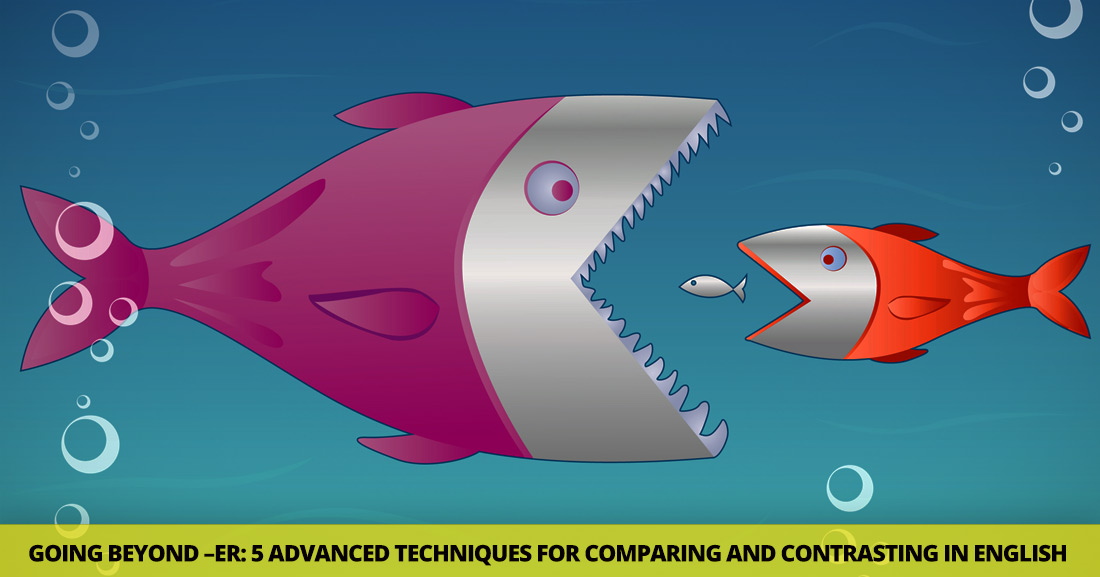All about Adverbs: Every Level Review with Exercises Part 1


Comparing and contrasting are a part of everyday life, and learning to do it well is important for ESL students. Often, however, we teach comparative and superlative adjectives and leave it at that. There are lots of other ways to compare and contrast in English. Once your students are comfortable with more and most, try teaching these comparison techniques.
One of the simplest ways to show similarities and differences is through use of determiners. Words such as both, all, neither, and none can show how two items are the same. Consider the following sentences.
Using determiners to show similarities is basic grammar, and even beginning students can use this technique when they speak and write in English. In fact, you can teach this type of comparison before you teach comparative and superlative adjectives it is so simple.
To practice using determiners for comparisons, have students work with a partner to find as many similarities between their home cultures as possible (or between their home culture and U.S. culture). They should express each similarity using a determiner that shows similarities. For example, students might say the following.
Adverbs can also be used to show similarities and differences between items. Consider the following sentences.
It’s the phrase in common, acting as an adverb in the sentence that shows the similarity between Jason and Jude. Other words and phrases that can show similarities in this way are as well, also, in the same way, so do, like, and likewise.
To practice using these phrases, have students work with a partner. One person make as observation about a person or object. For example, The filing cabinet is made of metal. The second person must find another person or thing that also has that quality. E.g. My car is made of metal. The first person then makes a sentence which shows the commonality between the two objects using an adverb or adverb phrase. E.g. The filing cabinet is made of metal and your car is as well.
When we evaluate two things using comparative adjectives, we must necessarily put both of those items in the same phrase. For more advanced sentence structure, your students can use linking expressions to compare and contrast in separate clauses. Consider the following sentences:
Both sentences express the difference in size for the two continents, but the sentence structure is very different. The first sentence is a simple sentence with only one clause. The second is a complex sentence with one independent clause and one dependent clause. Here is another example.
The sentences in this pair do not have the exact meaning and are therefore not interchangeable, but both do show a contrast between the two people. Again the second sentence is a complex sentence whereas the first is a simple sentence.
While and although are other linking expressions that can be used this way.
To practice this method of comparing and contrasting, have the members of your class write several phrases on individual index cards. Each should use a linking expressions. Students might write thing such as the following:
Collect the cards and shuffle them. Read them to your class and ask students to complete the sentences logically. You can take several answers for each phrase.
Adjectives are great ways of comparing two items, but you can also use nouns and verbs to show similarities and differences. When they are used for this purpose, the nouns and verbs imply similarities and differences as part of their meaning.
Some verbs that compare and contrast are differ, contrast, compare, vary, change, equate, equal, match, and parallel.
Some nouns that compare and contrast are difference, similarity, contrast, comparison, variance, dissimilarity, change, resemblance, likeness, parallel, connection, and match.
To practice using nouns and verbs to show similarities and differences, start with several sentences that use comparative adjectives written out on a worksheet. Have students rewrite the sentences using a noun or verb instead of the comparative adjective. For example, students might change sentences as follows.
Sometimes we want to do more than just say two things are alike or are different. We want to say just how different they are. We want to know the degree of similarity or difference. To express these ideas, English speakers use a word or phrase to modify the adjective they are using. The following phrases express degrees which can be combined with an adjective to say just how similar or different two items are: absolutely the same/different, exactly the same, practically the same/opposite, basically the same/different/opposite, nearly the same, more or less the same/different, quite similar/different, completely the same/different, totally the same/different, slightly similar/different, and very similar/different.
To practice these expressions, try having your students describe just how alike or different people in your class are. Have students write ten sentences each comparing or contrasting two of their classmates. In each sentence, students should use a phrase that expresses just how alike or different those student are. For example, someone might write the following.
Try teaching these more advanced techniques of comparison and contrast and see just how much more impressive their English use can become.